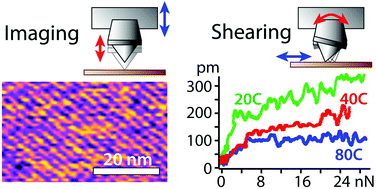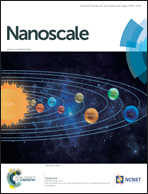Effect of temperature on the viscoelastic properties of nano-confined liquid mixtures†
Abstract
The behaviour of fluids confined in nanoscale gaps plays a central role in molecular science and nanofluidics, with applications ranging from biological function to multiscale printing, osmosis and filtration, lab-on-chip technology and friction reduction. Here atomic force microscopy is used to shear five different mixtures of hexadecane and squalane confined between the tip apex and atomically flat graphite. The shearing amplitudes are typically <2 nm, hence reflecting highly localised information at the interface. The evolution of each mixture's viscoelastic properties is studied as a function of temperature, between 20 °C and 100 °C. The results, complemented by sub-nanometre resolution images of the interface, show that spatial organisation of the liquid molecules at the surface of graphite largely dominates the measurements. Squalane presents a higher effective affinity for the surface by forming a robust self-assembled layer in all mixtures. This results in a step-like change of the viscous and elastic response of the confined liquid as the confining pressure increases. In contrast, measurements in pure hexadecane show a continuous and linear increase in the apparent viscosity with pressure at all temperatures. This is interpreted as a more fragile interfacial layer and images show that it can be completely removed at high temperatures. Depending on the mixture composition, measurements can be strongly location-dependent which suggests molecular clustering and nanoscale phase separation at the interface.

- This article is part of the themed collection: 2016 Nanoscale HOT Article Collection

 Please wait while we load your content...
Please wait while we load your content...